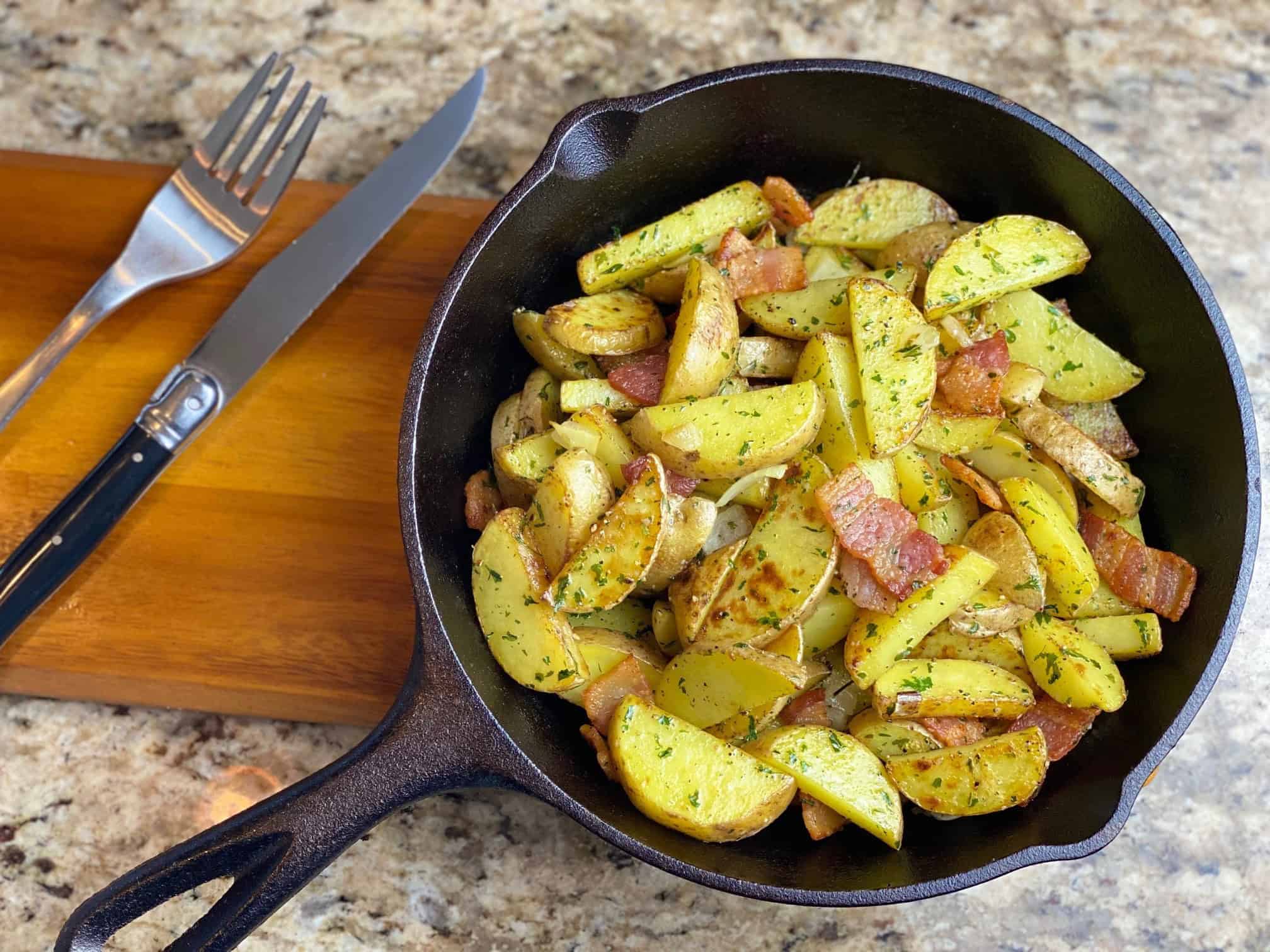Potatoes play a key role in diet and healthy aging, providing nutrients that support strength, cognition and vitality. This article explores how Wisconsin potatoes fit into a healthy aging diet with potassium, vitamin C, fiber and high-quality plant protein. Registered Dietitian Nutritionist, Jenny Heap, shows you how you can support healthy aging and senior nutrition during the holidays and offers nutrition tips for healthy aging.
By: Jenny Heap MS, RDN
Baked, boiled, scalloped, or mashed; smashed for pancakes, perogies, kugel, or latkes; or cooled to make Grandma’s famous potato salad, potatoes have been a comforting staple in North American fare since the 18th century when Irish immigrants first introduced them in New Hampshire and sparked broader cultivation. [1] It’s no wonder that potato dishes spark nostalgia during celebrations and family gatherings. But potatoes can be more than a comfort food for seniors this season. Thoughtful preparation can bring satisfying nutrition to the holiday table.
How Seniors Benefit from Potassium, Vitamin C and Fiber
The Dietary Guidelines for Americans calls out specific nutrients of concern for seniors. Of course, nutrient needs vary by individual, but generally speaking, seniors are at risk for under consuming potassium, calcium, vitamin D, dietary fiber, protein, vitamin B12, and fluids for hydration.[2]
Potatoes and potato dishes can help boost consumption of several of these nutrients of concern along with other nutrients that support health and wellness for seniors.
One medium 5.3 ounce potato provides:
620mg Potassium
620 mg, 15% DV (24% and 18% DRI for women and men 50+, respectively)
Potassium is necessary for healthy heart and kidney function, muscle contraction, and nerve transmission. Inadequate intake can increase blood pressure and deplete the calcium in bones.
Potassium is found primarily in the flesh of the potato. Removing the skin reduces potassium by ~150mg.
2g Dietary Fiber
2g, 7% DV (9% and 7% DRI for women and men 50+, respectively)
The fiber in potatoes, composed mostly of cellulose, enhances satiety and may contribute to a healthier gut microbiome and help reduce inflammation. In addition, fiber promotes bowel regularity, which can worsen with age, especially with a reduction in physical activity and/or fluid intake. Fiber is the only nutrient significantly reduced when a potato is peeled. A little less than 50% is found in the skin, so leave the peel on to optimize fiber.
3g High-Quality Protein
3g (7% and 5% DRI for women and men 50+, respectively)
Prioritizing adequate protein intake is a must to prevent muscle loss that happens naturally as part of the aging process (sarcopenia). Sarcopenia not only affects strength and functional physical performance, but is also associated with cognitive decline, accelerated progression of cardiovascular disease, increased risk of death, disability, and reduced quality of life. [3] Of note, sarcopenia is also associated with cognitive decline.
While potatoes are not a rich source of protein, it’s the biological value (BV) that might surprise you. Depending on variety, the BV comes in anywhere between 90 and 100 –approaching that of an egg – and is higher in biological value than protein from both soybeans (84) and beans (73).[4] [5]Potatoes offer more per serving than most other foods commonly consumed from the vegetables and legumes category.
20mg Vitamin C
20mg, 30% DV (36% and 30% DRI for women and men 50+, respectively)
Vitamin C is essential for the synthesis of collagen, which provides structure and elasticity to connective tissues throughout the body. It also supports wound healing and immune function. Another important benefit of vitamin C is that it improves the bioavailability of iron found in plant foods. About ~4.5mg vitamin C is lost when potato skin is removed.
1mg Iron
1mg, 6% DV (14% and 14% DRI for women and men 50+, respectively)
Though not a significant source of iron, potatoes’ impressive vitamin C content and very low (to nonexistent) antinutrient levels make the bioavailability shine compared to that of many other plant foods rich in iron.[6] Research suggests that inadequate iron intake later in life may lead to cognitive impairment. [7]
2mg Vitamin B6
2mg, 10% DV (13% and 12% DRI for women and men 50+, respectively)
This B vitamin plays an important role in immune function, protein and carbohydrate metabolism, and though more research is needed, may play a role in cognitive function in later years. Inadequate intake can lead to microcytic anemia and associated weakness and fatigue. [8]
7mg Magnesium
7mg, 11% DV (15% and 11% DRI for women and men 50+, respectively)
Magnesium helps regulate blood pressure and blood glucose levels, along with muscle and nerve function. Research suggests that 5% of the magnesium in Americans’ diets comes from potatoes. [9]
Phytonutrients
Potatoes are rich in antioxidants. Beyond vitamin C, they offer polyphenols, anthocyanins, and flavanols in varying amounts depending on the variety. Many varieties are grown locally in Wisconsin, including red, blue and purple, white, yellow-gold, Russet and Fingerling.
Potatoes are already a nutritional powerhouse, providing a rich source of nutrients critical to preserving and promoting health and wellbeing. But the versatility of potato dishes allows them to go even further for seniors. Pairing potatoes with ingredients that provide complementary nutrients is a powerful way to nourish and satisfy.
Nutrition Tips for Healthy Aging with Potatoes
- For a protein boost, top a baked potato with Greek yogurt. The yogurt packs a punch with three times the protein and half the calories of traditional sour cream.
- Add vitamin D to the mix:
- Sauté mushrooms that have been exposed to UV light—look for it on the label! While vitamin D levels vary, one 1/2 cup serving of these mushrooms can provide up to 46% of the Daily Value in a single baked potato meal.
- Turn your baked potato into a scramble. Two large eggs provide 11% Daily Value for vitamin D and 20% Daily Value for B12. (NOTE: Neither vitamin D nor B12 is found in egg whites, so be sure to include the yolks for this nutrient power-up!)
- For seniors watching sodium intake, unsalted butter greatly reduces sodium. A drizzle of olive oil has no sodium and is an opportunity to add monounsaturated fat. For a completely different experience, use a flavored olive oil that complements other toppings.
Support a Healthy Aging Diet with Holiday Potato Dishes
The holiday season can offer valuable opportunities to optimize nutrition for seniors. Serving nutrient-dense meals in social settings or during family gatherings can be especially important for seniors with low appetites, who may find it difficult to eat enough on their own. Festive potato meals – especially those that pack complementary nutrients – can help nourish and satisfy seniors during the holidays and beyond.
To learn more about the Wisconsin Potato Growers Association and their Wisconsin Healthy Grown Potatoes certification, visit eatwisconsinpotatoes.com.
Content produced in partnership with the Wisconsin Potato and Vegetable Growers Association.
The Wisconsin Potato and Vegetable Growers Association represents growers committed to good agriculture, food safety, nutrition, traceability, and providing America with fresh, high-quality produce. Wisconsin-grown potatoes offer more than just great taste. Local and sustainably sourced, they’re packed with nutrition no matter the variety. Every one of our Wisconsin Healthy Grown® farms is certified by an independent oversight organization. It ensures our growers pass annual Wisconsin Healthy Grown® Potato and Vegetable whole-farm audits, and that all our packers and shippers maintain the highest sustainability standards.
Look for the Wisconsin Healthy Grown® certification
Additional content:
| % daily recommendation supplied by medium skin-on potato* | |||||
| Nutrient | Medium potato provides | Female 51+ | Male 51+ | ||
| Dietary Reference Intake (DRI)** | % from potato | Dietary Reference Intake (DRI)** | % from potato | ||
| Dietary fiber | 2g | 22g | 9% | 28g | 7% |
| Protein | 3g | 46g | 7% | 56g | 5% |
| Potassium (AI) | 620mg | 2600mg | 24% | 3400mg | 18% |
| Vitamin B6 | 0.2mg | 1.5mg | 13% | 1.7mg | 12% |
| Iron | 1.1mg | 8mg | 14% | 8mg | 14% |
| Magnesium | 46.7mg | 320mg | 15% | 420mg | 11% |
| Calcium | 20mg | 1200mg | 2% | 1000mg | 2% |
| Protein | 3g | 46g | 7% | 56g | 5% |
| Vitamin C | 27mg | 75g | 36% | 90g | 30% |
* Data from Potatoes USA
** Appendix 1, U.S. Department of Agriculture and U.S. Department of Health and Human Services. Dietary Guidelines for Americans, 2020-2025. 9th Edition. December 2020.
Carbohydrates: 26g
Potatoes provide 26g complex carbohydrates. Glucose is the fuel required by red blood cells, the brain, and central nervous system. In fact, the Estimated Average Requirement (EAR) for carbohydrate – 130 grams of carbohydrates per day – was calculated based on the brain’s glucose requirements alone. Carbohydrate is also stored in the muscles as glycogen to ensure a ready fuel supply for daily activity.
Much of the carbohydrate in potatoes comes in the form of resistant starch (RS), an emerging topic of interest among researchers. Resistant starch is not broken down during digestion, but is fermented in the colon by gut microbes, producing short-chain fatty acids (SCFAs) believed to help regulate insulin sensitivity and glucose metabolism, among other benefits. [10] [11]
Note: About 1/3 of the starch in a raw potato is resistant starch (RS), but the proportion varies greatly depending on preparation method. The cooking process makes RS more digestible, thus decreasing the proportion of starch available to produce SCFAs. Cooling the potatoes after cooking returns much of the starch to its resistant state.
According to a 2019 study, cooling the potatoes for several days after cooking them maximized the RS content. Reheated potatoes retained much of the RS and ultimately provided more than the potatoes that were not cooled before eating. The study also indicated that RS was higher in baked vs. boiled potatoes.
[1] Sauer J. Historical Geography of Crop Plants: A Select Roster. Boca Raton, FL: CRC Press; 2017:320
[2] U.S. Department of Agriculture and U.S. Department of Health and Human Services. Dietary Guidelines for Americans, 2020-2025. 9th Edition. December 2020.
[3] Damluji AA, Alfaraidhy M, AlHajri N, et al. Sarcopenia and Cardiovascular Diseases. Circulation. 2023;147(20):1534-1553. doi:10.1161/CIRCULATIONAHA.123.064071
[4] King JC, Slavin JL. White potatoes, human health, and dietary guidance. Adv Nutr. 2013;4(3):393S-401S. Published 2013 May 1. doi:10.3945/an.112.003525
[5] McGill CR, Kurilich AC, Davignon J. The role of potatoes and potato components in cardiometabolic health: A review. Ann Med. 2013;45(7):467-73.
[6] Beals, K.A. Potatoes, Nutrition and Health. Am J Potato Res. 2019;96:102–110. https://doi.org/10.1007/s12230-018-09705-4
[7] Tardy AL, Pouteau E, Marquez D, Yilmaz C, Scholey A. Vitamins and Minerals for Energy, Fatigue and Cognition: A Narrative Review of the Biochemical and Clinical Evidence. Nutrients. 2020;12(1):228. Published 2020 Jan 16. doi:10.3390/nu12010228
[8] Tardy AL, Pouteau E, Marquez D, Yilmaz C, Scholey A. Vitamins and Minerals for Energy, Fatigue and Cognition: A Narrative Review of the Biochemical and Clinical Evidence. Nutrients. 2020;12(1):228. Published 2020 Jan 16. doi:10.3390/nu12010228
[9] Beals, K.A. Potatoes, Nutrition and Health. Am J Potato Res. 2019;96:102–110. https://doi.org/10.1007/s12230-018-09705-4
[10] Canfora EE, Jocken JW, Blaak EE. Short-chain fatty acids in control of body weight and insulin sensitivity. Nat Rev Endocrinol. 2015;11(10):577-591. doi:10.1038/nrendo.2015.128
[11] Kim MK, Park J, Kim DM. Resistant starch and type 2 diabetes mellitus: Clinical perspective. J Diabetes Investig. 2024;15(4):395-401. doi:10.1111/jdi.14139
About the Author:
Jenny Heap, MS, RDN, is a registered dietitian nutritionist who contributes nutrition expertise to the educational outreach of Wisconsin Potato and Vegetable Growers Association. Connect with Jenny on LinkedIn.



